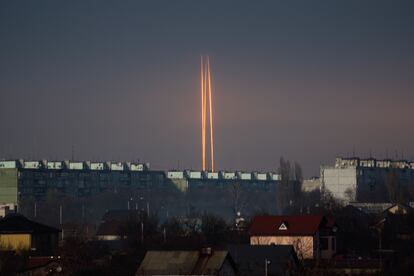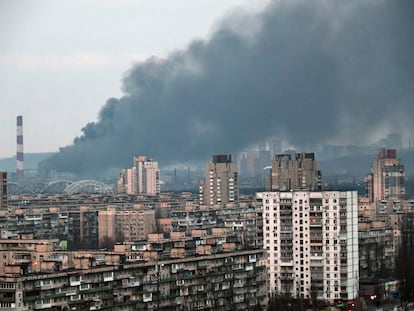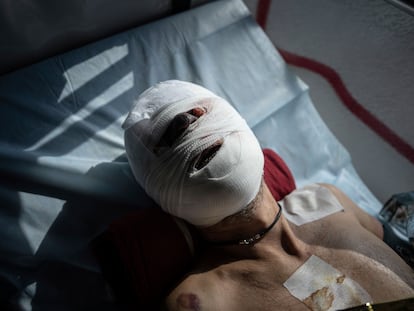Russian strikes in Ukraine kill at least 10 civilians
The attacks came as a senior Moscow official warned Friday that the Kremlin’s forces are prepared for an expected Ukrainian counteroffensive in the coming week

Russian long-range strikes killed at least 10 civilians and wounded 20 others in several areas of Ukraine on Friday, Ukraine’s presidential office said, as a senior Moscow official warned that the Kremlin’s forces were prepared for an expected Ukrainian counteroffensive in the coming weeks.
Five people died in Kostiantynivka, a town in eastern Ukraine’s Donetsk province, when a Russian missile hit an aid station. Ukrainian authorities last year established hundreds of so-called “points of invincibility,” where residents hard-pressed by the war could warm up, charge their cellphones and get snacks.
Local prosecutors said the Russians attacked Kostyantynivka with S-300 anti-aircraft missiles. The civilians who died were refugees, according to Donetsk Gov. Pavlo Kyrylenko.
As the mostly artillery war of the recent winter months stretched into its second spring, Russian forces also used air-launched missiles, exploding drones and gliding bombs in their attacks on several regions early Friday, Ukrainian air force spokesman Yurii Ihnat said.
Two civilians were killed and nine were wounded in the Sumy province town of Bilopillia by a nighttime rocket and artillery barrage and air strikes, the administration of the northeast region said.
In the southern Kherson region, which Ukrainian President Volodymyr Zelensky visited Thursday, Russian shelling killed one person in the main city, also called Kherson, and killed another person and wounded four others in the town of Bilozerka.
On Wednesday, a Russian drone attack struck a high school and dormitories south of Kyiv, killing at least nine people.
Kyiv’s forces are poised to use the improved spring weather and the arrival of modern weapons supplied by its Western allies, including tanks, to launch a counteroffensive aimed at dislodging Russian troops from occupied areas of Ukraine.
But Dmitry Medvedev, Russia’s former president and now the deputy head of Russia’s Security Council chaired by President Vladimir Putin, said the Russian military was ready to repel a counterattack.
“Our General Staff is assessing all that,” Medvedev said.
He also said that a Ukrainian attempt to seize Crimea, which Russia annexed in 2014, could trigger a nuclear response from Moscow.
“An attempt to split part of the state away means an encroachment at the very existence of the state,” he said. “Quite obviously, it warrants the use of any weapons. I hope our ‘friends’ across the ocean realize that.”
Though known for his bombastic pronouncements, Medvedev’s warning stems from the Russian security doctrine envisaging the use of nuclear weapons in response to a nuclear attack or an attack with conventional weapons that threatens “the very existence of the Russian state.”
Medvedev also said that Western experts operating weapons, such as the U.S.-made Patriot air defense missile systems supplied to Ukraine, would be legitimate targets for the Russian military. Ukrainian soldiers have received training in the U.S., although Russian officials have frequently claimed that foreign instructors are present in Ukraine.
“If Patriot or other weapons are delivered to the territory of Ukraine along with foreign experts, they certainly make legitimate targets, which must be destroyed,” Medvedev told reporters in video clips he posted on his messaging app channel. “They are combatants, they are the enemies of our state and they must be destroyed.”
“They must understand that as soon as an American or a Polish soldier shows up there, he must be killed,” he added.
The Kremlin’s goal is to “create a sanitary cordon” of up to 100 kilometers (60 miles) around Russian-held areas so short- and mid-range weapons can’t strike them, according to Medvedev.
Moscow may even set its sights on grabbing a bigger chunk of Ukrainian territory, stretching all the way to the border with Poland, he said.
Sign up for our weekly newsletter to get more English-language news coverage from EL PAÍS USA Edition
Tu suscripción se está usando en otro dispositivo
¿Quieres añadir otro usuario a tu suscripción?
Si continúas leyendo en este dispositivo, no se podrá leer en el otro.
FlechaTu suscripción se está usando en otro dispositivo y solo puedes acceder a EL PAÍS desde un dispositivo a la vez.
Si quieres compartir tu cuenta, cambia tu suscripción a la modalidad Premium, así podrás añadir otro usuario. Cada uno accederá con su propia cuenta de email, lo que os permitirá personalizar vuestra experiencia en EL PAÍS.
¿Tienes una suscripción de empresa? Accede aquí para contratar más cuentas.
En el caso de no saber quién está usando tu cuenta, te recomendamos cambiar tu contraseña aquí.
Si decides continuar compartiendo tu cuenta, este mensaje se mostrará en tu dispositivo y en el de la otra persona que está usando tu cuenta de forma indefinida, afectando a tu experiencia de lectura. Puedes consultar aquí los términos y condiciones de la suscripción digital.
More information
Archived In
Últimas noticias
Most viewed
- Reinhard Genzel, Nobel laureate in physics: ‘One-minute videos will never give you the truth’
- Oona Chaplin: ‘I told James Cameron that I was living in a treehouse and starting a permaculture project with a friend’
- Pablo Escobar’s hippos: A serious environmental problem, 40 years on
- Why we lost the habit of sleeping in two segments and how that changed our sense of time
- Chevy Chase, the beloved comedian who was a monster off camera: ‘Not everyone hated him, just the people who’ve worked with him’










































